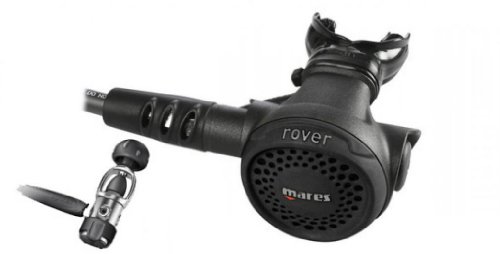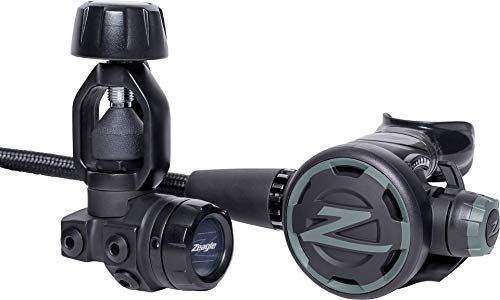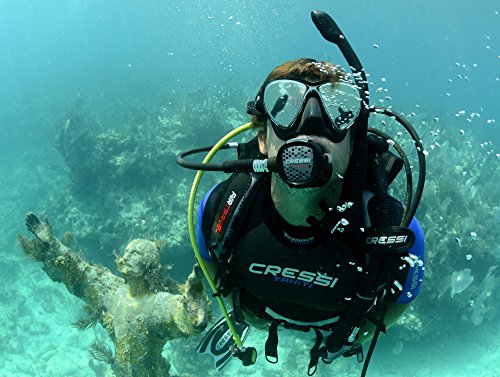This post may contain compensated links, please read our disclaimer for more info.
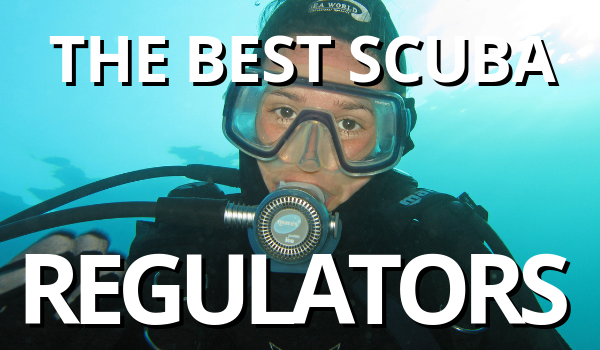
If you want to go scuba diving, you are going to need to breathe underwater and the only way to do that is by using a scuba regulator. Unlike many ‘nice-to-have’ scuba accessories a diving regulator really is a non-negotiable part of scuba diving. Not long after getting certified a lot of divers find that they want to start collecting their own scuba equipment. Often getting their own regulator set is one of their first considerations. But, what is the best scuba regulator? This isn’t necessarily the most expensive one, but the best dive regulator for you. The one that best fits your needs. Today, we are going to discuss some of the top scuba regulators and scuba gear online so you can make an educated decision about the best scuba regulator set for you.
This post contains affiliate links, see our disclaimer for more info.
Contents
- 1 SCUBA REGULATOR QUICK GUIDE
- 2 Benefits of having your own scuba equipment
- 3 Best scuba regulator comparison table
- 4 How much does scuba gear cost?
- 5 Components of a scuba regulator set
- 6 Different scuba Diving Regulator Types
- 7 What to look for in a diving regulator
- 8 Maintaining your scuba regulator
- 9 Dive regulator reviews
- 9.1 Best scuba regulator on the market – Atomic Aquatics T3 review
- 9.2 Best Travel scuba Regulator – Aqua Lung Mikron review
- 9.3 Best scuba regulator for the money – Sherwood SR2 review
- 9.4 Best Value scuba Regulator – Zeagle F8 review
- 9.5 Best Midrange scuba Regulator – Aqua Lung Titan
- 9.6 Best Cold Water Regulator – Maress Abyss 22 review
- 9.7 Best scuba Regulator For Beginners – Mares Rover 15x review
- 9.8 Best Tech Diving Regulator – Hollis 500SE / DC7
- 9.9 Best Budget scuba Regulator – Cressi AC2 / XS2
- 9.10 Best Midrange scuba Regulator – Scubapro MK11/C370 review
- 9.11 Best Regulator For Female Divers – Aqua Lung Legend LX Twilight
There are so many different options for dive regulators and scuba diving gear packages available today. Picking the best scuba diving equipment, may that be the top diving regulators or the best BCD, is always going to come down to the personalization for YOUR dives and your budget. What kind of dives do you make, how often do you dive and many other considerations come into play when deciding what gear to buy. That’s why we’ve included everything you need to know about the top diving regulators. From understanding the parts of a regulator all the way down to individual scuba regulator reviews so that you can have confidence in your purchase…and then go have fun diving!
SCUBA REGULATOR QUICK GUIDE
Benefits of having your own scuba equipment
When deciding if you should get your own scuba gear, there are a lot of reasons why owning your own is ideal.You know it’s well cared for
When you rent gear from a dive shop, you are trusting that it has been maintained well, cleaned properly, has had safety checks and more. Those are a lot of variable factors when you are talking about equipment that is keeping you alive while diving! Of course you can guess, but with your own gear you KNOW that it’s well maintained, clean and properly cared for.
No learning curve
Each time you rent dive equipment, there is potential for a slight learning curve. For most equipment it’s typically minimal, but dive computer interfaces can vary a lot. So buying your own dive computer is definitely recommended. When you have your own gear you can dive right in (pun intended) and can start enjoying the waters as soon as you descend.
No recurring costs
While it may seem expensive to buy all of your own gear initially, if you plan on diving frequently, it just makes sense to have your own. Paying for rental dive equipment each and every time you want to dive really adds up over the years. This makes total sense when you often do local dives, but also when traveling you can save a lot when you (partly) have your equipment.
Comfort
Dive shop gear should absolutely be up to safety standards. But by purchasing your own gear, you can choose equipment based on your own preferences, giving you personalized comfort. Nothing ruins a dive quicker than an uncomfortable mouthpiece regulator that hurts your gums and gives you jaw fatigue.
Greatly improved diving experience
All of the above combined is going to give you such an improved dive experience. After all, diving should be fun and enjoyable! Getting your equipment right really is a large part of it. It seems like a daunting task, but once you have all your gear you’ll be able to enjoy it for a long time.
Best scuba regulator comparison table
| SCUBA REGULATOR | TYPE | BALANCED? | SEALED? | PORTS | PRICE |
|---|---|---|---|---|---|
Atomic Aquatics T3 Titanium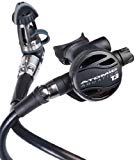  | piston | yes | yes | 2 HP / 5 LP | best scuba regulator on the market  |
Aqua Lung Mikron  | diaphragm | yes | no | 2 HP / 4 LP | best travel scuba regulator  |
Sherwood SR2  | piston | yes | yes | 2 HP / 5 LP | best scuba regulator for the money  |
Zeagle F8  | diaphragm | yes | yes | 2 HP / 5 MP | best value scuba regulator  |
Aqua Lung Titan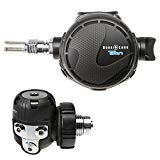  | diaphragm | yes | yes | 2 HP / 4 LP | best mid range scuba regulator  |
Mares Abyss 22 Navy II  | diaphragm | yes | yes | 2 HP / 4 LP | best cold water regulator  |
Mares Rover 15X  | diaphragm | yes | no | 2 HP / 4 LP | best scuba regulator for beginners  |
Hollis DC7/500SE  | overbalanced diaphragm | yes | yes | 2 HP / 4 LP | best tech diving regulator  |
Cressi AC2/XS2  | piston | no | no | 1 HP / 4 LP | best budget scuba regulator  |
Aqua Lung Legend LX Twilight Supreme  | overbalanced diaphragm | yes | yes | 2 HP / 4 MP | best regulator for female divers  |
Scubapro MK11/C370  | overbalanced diaphragm | yes | yes | 2 HP / 4 LP | best midrange scuba regulator  |
How much does scuba gear cost?
People who dive frequently quickly realize that purchasing their own gear is probably a better use of money than the recurring costs of renting. So, how much is scuba gear? The great thing about dive equipment is that you don’t need it all at once. Pick a few pieces that you would rather have your own instead of renting and start with those.
Scuba diving equipment costs can vary depending on what all you want. Some of the first items people generally buy themselves are:
- Masks
- Fins
- Snorkel
You can expect to spend about $150-$200 on these items, but having your own that fit you well and are comfortable are typically well worth the price. Check out our snorkel gear guide for more info about masks, snorkels and fins.
Next to follow usually are:
- BCD
- Regulator
- Dive Computer
These are some of the most important (and life-saving!) elements of your scuba diving gear. You absolutely do not want to skimp here and just go as cheap as you can get. This doesn’t mean that there are not really affordable and quality pieces of gear out there though. Being budget conscious is very different from being flat out cheap!
You can expect to spend well over $1000 for these important scuba gear items (combined), but trust us when we say that having your own if you dive frequently will actually save you money in the long run.
FOR MORE SCUBA GEAR RECOMMENDATIONS & REVIEWS ALSO CHECK:
Components of a scuba regulator set
When you get scuba certified, one of the most important things you learn in the class setting is how to do a proper scuba regulator setup. After all, no air underwater, no scuba diving!
However, sometimes the specifics of HOW your dive gear works is quickly glanced over. But, when you are wanting to buy your own gear, it is really important to understand exactly how each component works so that you can pick the best gear for YOU.
First, you need to understand why a regulator is essential. Not only is this the mechanism that will give you the air, but it is also what takes the highly pressurized air in your tank and will ‘convert’ it to a safe pressure for you to inhale while diving.
When people talk about a regulator, they are often referring to the WHOLE setup, which includes:
First, Second and Alternate Stages
First Stage Regulator: The first stage lowers the high tank pressure enough to come into the hose. The resulting intermediate pressure can be used by the diver’s second stage to provide air to breathe. Pressure will change not only as air changes in the tank but also depending on your depth.
Second Stage Regulator: Breathing the high pressurized air directly from your talk would damage your lungs. Hence you need the second stage. The second stage is the part that goes in your mouth and delivers the air as you breathe. It takes the pressurized air from your first stage and then regulates the ambient pressure to the water pressure so that it is easy and comfortable to breathe.
Alternate Stage: The Alternate Air (sometimes called ‘octopus regulator’ or simply ‘octopus’) is your backup. It’s a secondary second stage. You carry it in case something happens to your primary regulator or to give it to your diving buddy if they need air. You hope you never have to use your scuba regulator octopus, but for safety reasons you must obviously always have one.
Ports and hoses
Your first stage will have two different port types, high-pressure ports and low-pressure ports. Obviously, a high-pressure hose connects to a high-pressure port and a low-pressure hose connects to a low-pressure port. Typically you’ll have at least one high-pressure port and multiple low-pressure ones. A basic rule of thumb is that your submersible pressure gauge or dive computer connects to the high-pressure port and everything else (second stage, alternate, BCD) to the low-pressure ports. If you’re planning to use an air integrated dive computer and want to use a backup pressure gauge, make sure to get a first stage with two high-pressure ports.
Different scuba Diving Regulator Types
Now that we understand more about the basics of a scuba regulator, it’s easier to understand some of the other terminology that is thrown around, especially in how it relates and combines to work with other essential parts of your gear.
Din Valve vs Yoke Valve
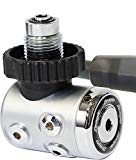
Your first stage is going to need to connect to your air tank. There are two primary ways to connect these:
INT Yoke Valve (INT or ‘International’ is the type more commonly used globally)
Scuba DIN Valve (DIN stands for “Deutsche Industrie Norm”)
Both types of valves achieve the same goal: to connect the tank and the first stage. The difference between a DIN Valve and a Yoke Valve all comes down to how they screw into the scuba air tank.
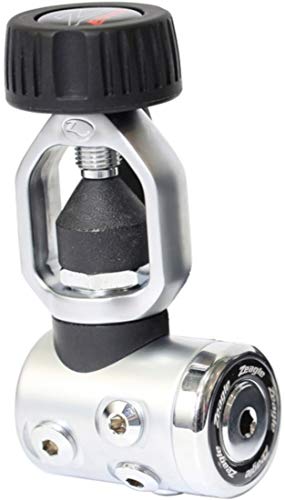
Yoke Valve: A yoke regulator valve is going to screw into the air tank valve “yoke style” over the top of the tank. You’ll also clearly see the O-ring seal on the front
DIN Valve Regulator: The DIN fitting is going to screw right into the tank valve and the O-ring will be a part of the first stage.
Divers wanting to do more technical dives, such as caves and wrecks often like to choose DIN valves. These have tighter connections and less of a chance to get knocked off or tangled in anything, preventing the risk of leaks.
DIN To yoke adapter
The great news is that you don’t need to be limited to one or the other today as you can now get a DIN to yoke adapter (sometimes also called DIN to yoke converter), allowing you a lot of flexibility.
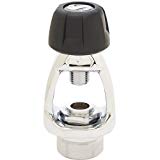
Please note that you can only buy adapters for DIN to yoke, yoke to DIN adapters don’t exist.
Each brand carries their own DIN to yoke adapter. Click here to see the various options >>
Read more about how to choose between a din or yoke valve below in the ‘Considerations’ section.
Piston vs diaphragm regulator in the scuba first stage
Another thing to check is if the 1st stage regulator has a piston or a diaphragm mechanism. This can get highly technical and if you really want to know the exact workings I recommend reading further about the two here. In short, a piston first stage is said to be more reliable, and easier and less expensive to maintain because it has a simpler design. All the internal workings in a diaphragm regulator are sealed. This not only means that it is protected from outside water (good for cold water diving) but also means it’s easier to clean and not as many contaminants get inside (see the section ‘Sealed vs unsealed’ below for more info).
So which one should you choose? Both designs have been around for over 50 years and work equally well, for recreational warm water diving purposes. Choosing one over the other seems to be largely a question of personal preference, and amongst more experienced divers you’ll find heated discussions about which design works best and why. Both the piston first stage and the diaphragm first stage have their advantages, and the most critical factor are the conditions in which you will be diving.
Piston 1st stage
Pros:
- Simple mechanism, more durable and reliable
- Easier and less expensive to service
Cons:
- More chance of free flow in cold water
- Unsealed piston regs need more rinsing
Diaphragm 1st stage
Pros:
- Easier to clean
- Performs better in extreme conditions (cold and/or dirty water)
- Practically all modern diaphragm first stages are balanced
Cons:
- Complicated mechanism, more parts that can fail
- More difficult to service
Balanced or unbalanced
Another term you might be coming across when choosing the best scuba regulator is ‘balanced’. We take about a balanced first stage, balanced second stage, balanced regulator etc.
If you’re into the technical side of scuba diving you might want tot know exactly how and why regulators work the way they do. Basically what balanced means is that the regulator stage (first or second) compensates for pressure changes and will always supply the same airflow. All diaphragm first stages are balanced, so this only goes for piston first stages and for second stages. Either your first stage can be balanced, or your second stage or both.
The pistons on your first stage regulator help to regulate the intermediate air pressure that will flow into your second stage. A basic explanation:
Balanced Piston: No matter the tank pressure (often due to water depth or amount of air in the tank) a balanced piston keeps the same intermediate pressure.
Unbalanced Piston: As the tank empties, an unbalanced piston give you a slightly lower intermediate pressure
It would reason to believe that a balanced (piston) first stage in combination with a balanced second stage is the way to go, as it is higher performing and makes breathing easier for the diver. This combination however is only found in high-end regulators and therefore expensive. A choice that’s often made is to have a balanced first stage, combined with an unbalanced second stage. At the lower end of the spectrum, you’ll find completely unbalanced sets, with both and unbalanced first stage and an unbalanced second stage. These are the cheapest available.
Like most considerations when it comes to choosing scuba gear, choosing a balanced vs non-balanced piston is highly dependent upon you, your diving skills, your budget and what kind of diving you do most.
Sealed vs unsealed
Here’s another factor to throw out at you: a sealed or unsealed first stage regulator.
What this means is that in an unsealed regulator, there is free flow water through the first stage. This also called ‘flow-through’ and as all diaphragm first stages are sealed, you can only have a flow-through piston stage. This is no problem in warmer temperatures and since unsealed regulators are typically cheaper, many tropical locations and divers go this route.
However, if you plan on doing cold water diving, you’ll want a sealed regulator so that water does not get inside the first stage where it can freeze. Frozen water in the first stage means air blockages, which you clearly do not want when that is the air you rely on for breathing! While a diaphragm first stage is always sealed, you can also buy a sealed piston first stage (also known as a ‘flow-by’ piston).
This environmental seal is also nice where keeping your regulator clean is concerned. The environmental seal helps keep contaminants (such as sand, sediment, salt crystals, etc) from getting into the first stage. You absolutely still need to clean and maintain a sealed regulator, but you do not have to be AS diligent and thorough as you might with an unsealed one.
What to look for in a diving regulator
When you’re looking for a scuba regulator for sale, there are quite a few things to keep in mind. So what should you consider before buying the best regulator for diving?
Scuba regulator package
When looking into buying your own beginner scuba gear, you’ll most likely want to purchase a scuba regulator set. You can buy each piece separate, but you can often find a good deal if you buy a complete package. Typically, a diving regulator set consists of:
- 1st stage regulator
- 2nd stage primary regulator
- 2nd stage octopus regulator
Check that the necessary hoses also come with these packages. You might also look into buying a set that includes either a console or dive computer.
Check out the best scuba regulator package >> Check out the best regulator package with console >> Check out the best regulator set with dive computer >>Considerations
Budget
One of the first things people look at when buying dive gear is the cost. Whichever way you look at it, dive gear is expensive. The great news is that there are really great, safe, and reliable regulators out there for every budget! And, keep in mind that once you have your own gear, diving becomes significantly cheaper.
Here is my favorite top of the line regulator and my favorite budget option
Warm vs cold water diving
Many regulators can handle a wide range of temperatures. However, if you know for a fact that you are going to be doing a lot of diving in particularly colder waters (really, anything less than 10ºC), then you’ll want a cold water regulator that won’t freeze up.
That means that you will be looking for regulators that have:
- Sealed first stage: this keeps the inside parts from coming in direct contact with the water.
- Metal second stage: this helps the gasses from expanding in extremely cold water.
My Recommendation For the Best Cold Water Regulator: Maress Abyss 22 Navy
The good news is that your cold water regulator works perfectly well in water of any temperature, so also on your tropical diving holiday.
DIN vs yoke
We talked about the difference between a yoke and DIN valve connector before. Apart from the technical aspects, the other thing to note about the differences between a DIN and INT yoke is where they are most commonly used. If you plan on traveling and diving globally (our dream!) you are more likely to come across INT yokes. Practically all rental tanks have yoke valves in locations outside of Europe. However, a DIN valve can often found in Europe if that is where you intend on diving a lot.
As mentioned earlier, if you do a lot of technical diving, you’ll most likely want a regulator with a DIN fitting.
We both have regulator sets with a yoke connector as we almost never dive in Europe, and even our own tanks at home have a yoke fitting. We’ve been diving for 18 years and have never needed a DIN regulator. Like the piston vs diaphragm discussion, this also seems to be largely a matter of preference. If you’re likely to dive in locations with DIN valves, I personally would choose a DIN valve connector. You can get a DIN to yoke adaptor, but not the other way around! A DIN fitting plus an adaptor is not much more expensive than a INT yoke and gives you more flexibility. Of course, if you’re never likely to need a DIN fitting, why add another piece of gear you might forget?
Weight
The biggest reason to be concerned about weight is if you intend on traveling a lot with your scuba gear. You’ll want a travel regulator that isn’t too heavy if you need to fly to your scuba destination with your gear. TheApeks Flight regulator is by far the most lightweight regulator on the market at only 1.56 lbs, but there are other great options as well, such as the Aqua Lung Mikron. Check our post about lightweight scuba gear for travel.
Compact
If you are going to be traveling with your gear, you may also want to look into regulators that are compact and easy to pack. Way back when we chose the Mares Proton for this reason, nowadays there are many more options.
Comfort and Fit
Your 2nd stage regulator is the piece that actually goes in your mouth. If you’ve ever been diving, then you know that the scuba regulator mouthpiece can be incredibly stiff and extremely uncomfortable. There are a lot of different scuba diving mouthpiece designs, shorter, longer, smaller, wider, more or less flexible, with or without a ‘roof’ or ‘bridge’… The beauty of buying your own gear is that you can be comfortable instead of having to bite down hard just to keep the mouthpiece in. You can also buy a moldable mouthpiece (such as this custom fit mouthpiece by Seacure), that you can completely customize so it fits your mouth perfectly.
Diving positions and swivels
Another comfort feature is in having a swivel turret in your first stage for easy diving positions.
While most beginners like to take it easy, even with just a bit of confidence in the water, you just may find yourself doing some fun hovering positions. Having a regulator that has a swiveling first stage can help so that you can move around freely and be face up or down without issue, without any risk of jaw fatigue.
Diving frequency
If you know you are going to be diving a lot or in extreme conditions you obviously need a scuba regulator that is beyond just a beginner kit. While there is nothing wrong with a budget or beginner set, there are others that will handle more wear and tear and give you much more comfort and ease of breathing in the water. If you only dive during holidays, in warm water and not too often an entry level dive regulator works just as well (with good maintenance!).
Noise
All divers know the rhythmic sounds that your regulator makes as you breathe in and out, it can actually be quite soothing. But some are definitely quieter than others. If the noise is a concern of yours, check online scuba regulator reviews to find a second stage that’s more quiet or pose your question in a scuba forum such as Scuba Board.
Number of ports
There are several ports on a first stage regulator which allow you to connect the hoses. At the very minimum there’s a port for your second stage, your octopus, to connect to your BCD’s inflator hose and for your dive computer. The high pressure port (or ports) is for your console/gauge or your dive computer, the low pressure ports are for everything else. So in theory having one high pressure port and three low pressure ports is enough. This is what most entry level first stages will have. But… it’s good to think about your future dives. Do you want to add an air integrated dive computer? Or maybe switch to a dry suit in the winter time? For dry suit diving you need at least 4 low pressure ports. A second high pressure port is good so that you have the flexibility of adding an air integrated dive computer with a transmitter in combination with a back up console.Therefore, do consider the number of ports the first stage has.
Maintaining your scuba regulator
After paying for your own gear, you’ll want to be sure to keep it in pristine condition. Here are a few ways to ensure that your regulator is in tip top shape.
Fresh water rinse
After each dive, be sure to do a full fresh water rinse, cleaning it of all the salt and other particles that might cause it harm. Even if you did a fresh water dive, you still want to rinse out your gear and regulator so that all sediment and contaminants are not left to cause erosion and other internal issues.
Servicing your regulator
It is recommended (and often required if you want to maintain your warranty) that you get your regulator serviced once a year. This will make sure that your regulator is working properly for each use. An average scuba regulator service cost is around $100, give or take. The cost can vary depending on the complexity of your set, diaphragm or piston, balanced or non-balanced, sealed or non-sealed.
Dive regulator reviews
Now it’s time to dive (pun intended!) into the scuba diving regulator reviews.
There are a lot of regulator packages available so it can be hard work to compare them all. So, we’ve made a selection of the best scuba diving regulator sets on the market based on different criteria. For each of our categories, we’ve chosen the best option for you based off of personal experience as well as scuba regulator reviews from real users.
Check below for the best scuba regulator brands, the most reliable scuba regulator, the best travel regulator, the best budget regulator, the best regulator for beginners and more.
Best scuba regulator on the market – Atomic Aquatics T3 review
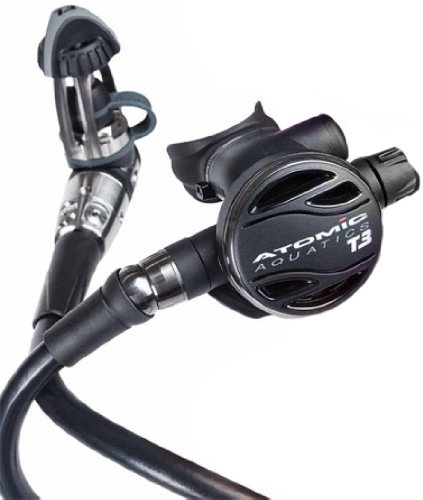 Atomic Aquatics is part of the Huish Outdoor Group together with other well known dive brands such as Zeagle and Bare Sports. The brand is recognized for its top quality products, especially their regulators. The Atomic Aquatics T3 Titanium is the best of the best and you definitely will get what you pay for. If you are a serious diver, this is the Atomic regulator to get. Sport Diver Magazine calls it ‘the ferrari of scuba diving’.
Atomic Aquatics is part of the Huish Outdoor Group together with other well known dive brands such as Zeagle and Bare Sports. The brand is recognized for its top quality products, especially their regulators. The Atomic Aquatics T3 Titanium is the best of the best and you definitely will get what you pay for. If you are a serious diver, this is the Atomic regulator to get. Sport Diver Magazine calls it ‘the ferrari of scuba diving’.
Made of titanium, the Atomic T3 Titanium regulator is extremely durable, yet lightweight with the yoke version coming in at just under 1.7 pounds – and that includes the second stage AND hose! The first stage is made of titanium which is much lighter than the regular steel versions so if you can afford it, this is one of the best travel regulator options for sale.
Its unique titanium design is non-corrosive. With its balanced piston first stage AND balanced second stage breathing underwater is effortless, despite the pressure changes. Being environmentally sealed, the T3 can be used for both cold and warm water diving. It’s not suitable for arctic environments though.
The comfort of this regulator is unparalleled. One of the reasons is because the ports are on a swivel, so the hoses can turn and move when you do. This also means that you don’t have to bite down just to keep the mouthpiece in place and there’s less chance of jaw fatigue.
This regulator is one of the most recommended among experienced divers, and for good reason.
Click here to check the current price of the Atomic Aquatics T3 Titanium >>
Best Travel scuba Regulator – Aqua Lung Mikron review
 ‘Great performance in a compact package’ is how Aqua Lung describes the Mikron regulator. This regulator is the smallest in the Aqua Lung collection and specifically designed with traveling divers in mind. Weighing only 31 oz. (893gr.) it’s the perfect regulator for your dive adventures abroad.
‘Great performance in a compact package’ is how Aqua Lung describes the Mikron regulator. This regulator is the smallest in the Aqua Lung collection and specifically designed with traveling divers in mind. Weighing only 31 oz. (893gr.) it’s the perfect regulator for your dive adventures abroad.
The Mikron’s environmentally sealed balanced diaphragm first stage is small and lightweight but performs great. The T-shape design optimizes the placement of the 2 HP and 4 LP/MP ports. The first stage of the Mikron is equipped with Aqua Lung’s patented Auto-Closure Device (ACD). This is a unique feature that prevents water and silt from entering the first stage by automatically closing as the Mikron is removed from the dive tank.
This Aqua Lung regulator has a pneumatically balanced second stage that guarantees smooth and easy breathing. The Mikron’s second stage has an Aqua Lung Comfo-Bite™ mouthpiece with a reusable mouthpiece clamp. A special knob allows divers to adjust the airflow, turned low it prevents free flows at the surface and the maxi position makes it easier to breathe while underwater.
Click here to see current prices for the AquaLung Mikron regulator >>
Best scuba regulator for the money – Sherwood SR2 review
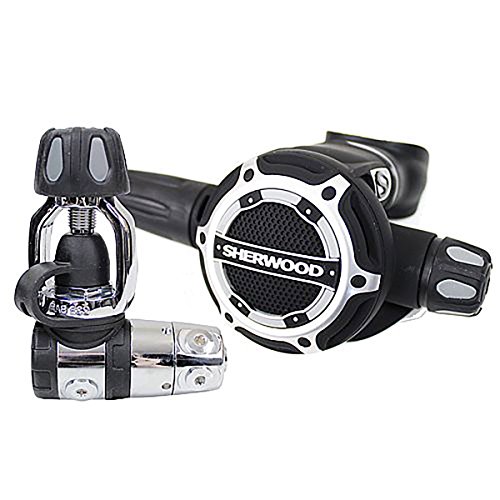 There’s a reason why Dive Techs and Dive Masters will all recommend the Sherwood brand to divers looking to buy a regulator.
There’s a reason why Dive Techs and Dive Masters will all recommend the Sherwood brand to divers looking to buy a regulator.
This compact and lightweight regulator packs a big punch. It is known for a superior breathing quality and control due to incredibly advanced manufacturing designs in the first stage.
The swivel makes it extremely comfortable for hose routing and the sealed first stage makes it ideal for cold water.
With 5 low pressure ports and 2 high pressure ports, this is a great option for divers wanting to use a dive computer with transmitter AND an analogue pressure gauge.
Click here to buy the Sherwoord SR2 >>
Best Value scuba Regulator – Zeagle F8 review
 Both Zeagle and Atomic Aquatics are owned by the Huish Outdoor Group, so you know you are getting great quality. Zeagle claims the F8 to be the ‘best performing diaphragm regulator on the market today’ and as such the price point is incredibly affordable. You can often find the Zeagle F8 regulator as part of a package deal with the Zeagle Halo BCD, which makes it a great value purchase.
Both Zeagle and Atomic Aquatics are owned by the Huish Outdoor Group, so you know you are getting great quality. Zeagle claims the F8 to be the ‘best performing diaphragm regulator on the market today’ and as such the price point is incredibly affordable. You can often find the Zeagle F8 regulator as part of a package deal with the Zeagle Halo BCD, which makes it a great value purchase.
The F8 first stage is an improvement of the famous Zeagle Flathead. It’s a sealed and balanced diaphragm first stage, coated in precision machined teflon to make it even tougher and more durable. The F8 regulator’s second stage has a new inhalation diaphragm, which is stronger and offers improved response time. Zeagle also redesigned the heat sink, which helps to avoid freeze-up and added an improved exhaust valve.
A lot of divers love the sleek, matte look and appreciate how easy it is to breathe with. It has great adjustability that is fantastic for dialing the perfect flow for your dive. The front cover/purge cover is available in different color kits, so you can even personalize your set (which is especially great if you have two identical sets like we have!).
Best Midrange scuba Regulator – Aqua Lung Titan
 This Aqua Lung regulator is a great middle of the road option. It isn’t going to be as lightweight and compact as some of the above competitors or offer AS much flexibility, but you’ll get an affordable, extremely durable and quality product that can’t be beat for the price.
This Aqua Lung regulator is a great middle of the road option. It isn’t going to be as lightweight and compact as some of the above competitors or offer AS much flexibility, but you’ll get an affordable, extremely durable and quality product that can’t be beat for the price.
With the sealed first stage, you know your gear is staying clear of debris. This and the fact that it has a heat exchange on the second stage means that it is great for cold water diving as well.
If you are a photographer, then you’ll really appreciate the very good bubble deflector.
Another great feature is the mouthpiece itself. It has a removable lip guard and is very comfortable in the mouth with interchangeable pieces depending on your preferences.
Read more Aqua Lung Titan reviews here >>
Best Cold Water Regulator – Maress Abyss 22 review
 When a regulator is approved to US Navy standards, like the Mares Abyss 22 Navy, then you know it’s manufactured to super high standards! The Navy Mares Abyss regulator is ‘Authorized For Military Use’ (or AMU) which means it’s designed to guarantee top performance and reliability under the toughest conditions.
When a regulator is approved to US Navy standards, like the Mares Abyss 22 Navy, then you know it’s manufactured to super high standards! The Navy Mares Abyss regulator is ‘Authorized For Military Use’ (or AMU) which means it’s designed to guarantee top performance and reliability under the toughest conditions.
This Mares regulator is the one to get if you are going to be diving in extreme conditions – such as ice diving – or if you just want a robust, durable and top quality regulator. The balanced and sealed diaphragm first stage with Dynamic Flow Control (DFC) is fitted with a CDW cold water oil kit. The full metal housing gives the Mares Abyss 22 Navy II regulator a phenomenal thermal transfer while being fantastically durable.
The Vortex Assisted Design (VAD) in the second stage of this Mares regulator ensures easy breathing at all depths. The air bypass tube delivers air to the mouthpiece, creating a swirling vortex with a low-pressure area in the center that keeps the diaphragm down during inhalation. The Mares Abyss 22 second stage is coated with a fluoropolymer resin finish, which makes it incredibly durable and strong.
Check the Mares Abyss 22 Navy’s current price and any discounts that may apply on Amazon >>
Best scuba Regulator For Beginners – Mares Rover 15x review
 This traditional regulator is everything you need without a ton of bells and whistles. There are two versions of the Mares Rover, the 15x and the 2s. They have identical second stages, but a different first stage. The Mares Rover 2s is often used as rental regulator, with an unbalanced piston first stage. The slightly more expensive Mares Rover 15x comes with a balanced diaphragm first stage, making it suitable for more diving conditions and excellent for novice divers. The first stage that features Advance Coating Technology (VAD) and Dynamic Flow Control (DFC) is small, compact and rugged which means it is built for longevity and reliability.
This traditional regulator is everything you need without a ton of bells and whistles. There are two versions of the Mares Rover, the 15x and the 2s. They have identical second stages, but a different first stage. The Mares Rover 2s is often used as rental regulator, with an unbalanced piston first stage. The slightly more expensive Mares Rover 15x comes with a balanced diaphragm first stage, making it suitable for more diving conditions and excellent for novice divers. The first stage that features Advance Coating Technology (VAD) and Dynamic Flow Control (DFC) is small, compact and rugged which means it is built for longevity and reliability.
Weighing only 35.45 oz. (or 1kg) this is an excellent travel regulator. Very suitable for both frequent diving as well as those of us not diving year-round, but looking for a good quality scuba regulator for an affordable price.
The lightweight second stage is extremely tough and has a very easy to activate purge. The Fluid Dynamic Deflector combined with the unique patented Vortex Assisted Design delivers effortless breathing, without having to use an adjustment knob. Free flows are minimalized.
The Mares Rover’s second stage has a very flexible, comfortable and lightweight mouthpiece with a double bite, making it feel weightless in the water.
This is a great Mares regulator for beginners as well as those needing something that will hold up to frequent dives.
Check the price of the Mares over 15x regulator >>
Best Tech Diving Regulator – Hollis 500SE / DC7
 This rugged and compact regulator is great for technical dives. The fixed hose routing is ideal for both back mount and side-mount configuration. The high performance over-balanced diaphragm first stage has 4 low pressure and 2 high pressure ports and is Nitrox compatible to 40% out-of-the-box. It has an environmental seal which makes it perfect for cold water as well as prevents it from getting contaminants into the gear.
This rugged and compact regulator is great for technical dives. The fixed hose routing is ideal for both back mount and side-mount configuration. The high performance over-balanced diaphragm first stage has 4 low pressure and 2 high pressure ports and is Nitrox compatible to 40% out-of-the-box. It has an environmental seal which makes it perfect for cold water as well as prevents it from getting contaminants into the gear.
This Hollis regulator comes standard with a 30” (75cm) braided maxflex hose, which is extremely flexible and UV protected. The pneumatically balanced second stage has large soft purge cover (eas to use with thick gloves!) and is great for divers needing to be in any orientation or direction as well as for handing off to a buddy. An obvious advantage of the side exhaust configuration is that you don’t get bubbles in your face when you exhale, a feature that underwater photographers will love! The patented orthodontic mouthpiece is light and comfortable with extra teeth grips, which come in particularly handy in cold water diving!
Find the Hollis 500SE/DC7 as well as any discounts that may apply on Amazon >>
Best Budget scuba Regulator – Cressi AC2 / XS2
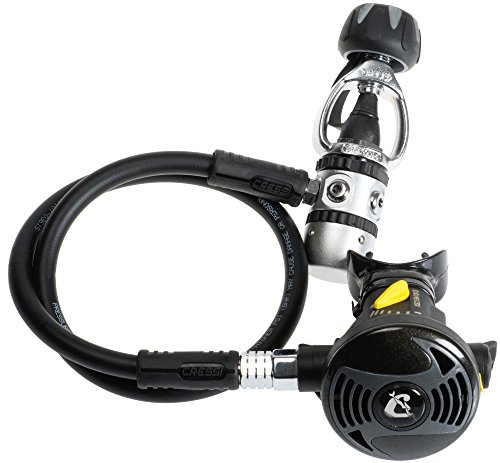 If you’re looking for a basic regulator, without any bells and whistles and at a very good price point, the Cressi AC2 / XS2 reg is a good choice. It’s the least expensive Cressi regulator, but it’s still Cressi and therefore extremely reliable and durable.
If you’re looking for a basic regulator, without any bells and whistles and at a very good price point, the Cressi AC2 / XS2 reg is a good choice. It’s the least expensive Cressi regulator, but it’s still Cressi and therefore extremely reliable and durable.
This is a great budget regulator, both for beginners and those of us looking for a basic reg that’s easy to use and maintain. It’s been around for a number of years and is therefore well tested and very well liked by lots of divers worldwide.
The non-balanced flow by piston first stage is best used in warmer waters (above 50F or 10C). It’s reliable and durable, and suitable for intense use. The AC2 first stage has 1 HP port and 4 LP ports. The XS2 second stage has a dependable downstream demand valve mechanism and a dive/pre-dive function.
Get your Cressi AC2/XS2 here >>
Best Midrange scuba Regulator – Scubapro MK11/C370 review
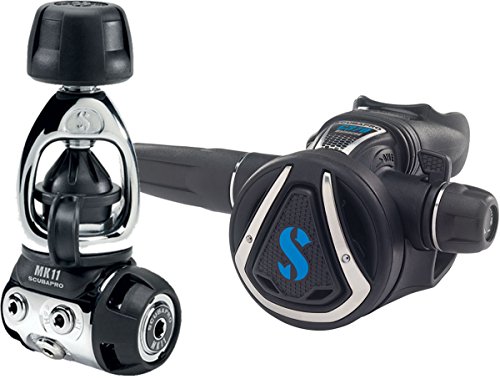 This is an extremely efficient, rugged and reliable regulator that’s also lightweight, which is great for travel. The compact rugged fiberglass reinforced nylon casing and new exhaust tee take up little space in a dive bag.
This is an extremely efficient, rugged and reliable regulator that’s also lightweight, which is great for travel. The compact rugged fiberglass reinforced nylon casing and new exhaust tee take up little space in a dive bag.
The MK11 first stage comes standard with the Thermal Insulating System (TIS), which means that it has excellent cold weather performance. Furthermore, it’s an over-balanced diaphragm first stage, ensuring smooth breathing and maximum performance that doesn’t diminish as your tank’s air pressure changes.
Paired with the C370, a powerflow downstream valve second stage, this makes an excellent but affordable set. The lightweight C370 has a diver-adjustable inhalation effort knob and Venturi-Initiated Vacuum Assist (VIVA). It also has a really handy switch that you can turn off and on to help prevent freeflow while at the surface.
This ScubaPro regulator is comfortable and delivers effortless airflow, making it a pleasure to dive with.
Click here to see current prices of the Scubapro MK11/C370 >>
Best Regulator For Female Divers – Aqua Lung Legend LX Twilight
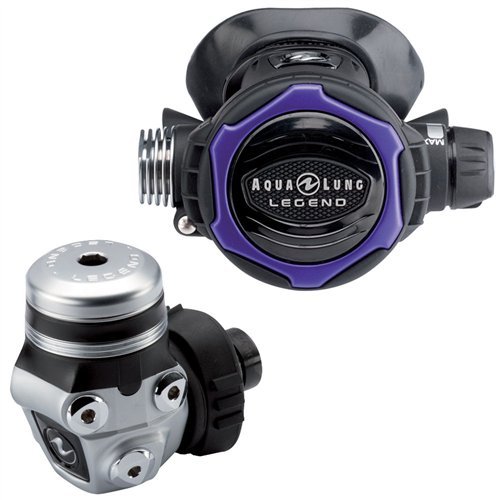 The Aqua Lung Legend LX Twilight is the ladies version of the Aqua Lung Legend LX, designed with women in mind. Fortunately, the Aqua Lung brand takes things further than just adding a funky color. The Twilight Legend LX has a lighter second stage and a smaller Comfo-Bite™ mouthpiece with detachable silicone bridge to minimize jaw fatigue. It comes with its own stylish twilight regulator bag.
The Aqua Lung Legend LX Twilight is the ladies version of the Aqua Lung Legend LX, designed with women in mind. Fortunately, the Aqua Lung brand takes things further than just adding a funky color. The Twilight Legend LX has a lighter second stage and a smaller Comfo-Bite™ mouthpiece with detachable silicone bridge to minimize jaw fatigue. It comes with its own stylish twilight regulator bag.
Furthermore, it has all the great features of the Legend LX regulator. The over-balanced, diaphragm first stage features the patented ACD (Auto Closure Device). Right out of the box it’s compatible with up to 40% O2 and has 2 HP and 4 MP ports. This Aqua Lung regulator’s second stage is pneumatically balanced and fitted with Aqua Lung’s Master Breathing System (MBS). MBS is a new way to adjust the breathing performance, it’s very simple and effective.
The supreme version of the Legend LX is specially adjusted to resist freezing and has an extra lip shield on the second stage to keep your lips warm.
Combine the Legend LX Twilight with the Aqua Lung Soul i3 BCD and the Shot FX fins for an awesome stylish equipment set with purple accents.
Get your Aqua Lung Legend LX Twilight here >>
As you can see, buying a regulator has quite a few variables, but when you have your own, it can make diving so much more comfortable and enjoyable!
Amazon Disclosure ScubaAroundTheWorld.com is a participant in the Amazon Services LLC Associates Program, an affiliate advertising program designed to provide a means for us to earn fees by linking to Amazon.com, Amazon.ca, Amazon.co.uk, Amazon.de, Amazon.fr, Amazon.se, Amazon.it and affiliated sites.


